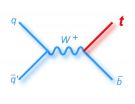(Press-News.org) ANN ARBOR—Simply making nanoparticles spin coaxes them to arrange themselves into what University of Michigan researchers call 'living rotating crystals' that could serve as a nanopump. They may also, incidentally, shed light on the origin of life itself.
The researchers refer to the crystals as 'living' because they, in a sense, take on a life of their own from very simple rules.
Sharon Glotzer, the Stuart W. Churchill Collegiate Professor of Chemical Engineering, and her team found that when they spun individual nanoparticles in a simulation—some clockwise and some counterclockwise—the particles self-assembled into an intricate architecture.
The team discovered the behavior while investigating methods to make particles self-assemble—one of the major challenges in nanotechnology—without complicated procedures. When the pieces are a thousand times smaller than a grain of sand, normal techniques for building structures are no longer effective.
For this reason, researchers like Glotzer are exploring ways to make order develop naturally from disorder, much like what may have occurred at the very beginnings of life.
"If we can understand that, not only can we begin to imagine new ways to make materials and devices, but also we may begin to understand how the first living structures emerged from a soup of chemicals," said Glotzer, who is also a professor of materials science and engineering, macromolecular science and engineering, physics, and applied physics.
"One way biology approaches the challenge of assembly is by constantly feeding building blocks with energy. So, that's what we did with nanoparticles."
Recently, researchers in the field have found that if particles are given energy for some basic motion, such as moving in one direction, they can begin to influence one another, forming groups. Glotzer's team looked at what would happen if the particles all were made to rotate.
"They organize themselves," said Daphne Klotsa, a research fellow in Glotzer's lab. "They developed collective dynamics that we couldn't have foreseen."
The team's computer simulation can be imagined as two sets of pinwheels on an air hockey table. The air pushing up from the table drives some of the pinwheels clockwise, and others counterclockwise. When the pinwheels are tightly packed enough that their blades catch on one another, the team found that they begin to divide themselves into clockwise and counter-clockwise spinners—a self-organizing behavior known among researchers as phase separation.
"The important finding here is that we get phase separation without real attraction," Klotsa said.
She calls the self-sorting counterintuitive because no direct forces push the same—spin pinwheels together or push opposite-spinners apart.
The separation occurs because of the way the pinwheel blades collide. While a pair of pinwheels may be spinning in the same direction, where their blades might meet, they're actually moving in opposite directions. This means that the blades will push into one another and stick together, causing the pair of pinwheels to rotate as one, at least briefly.
In contrast, the blades of opposite spinners are moving in the same direction where they meet, so they don't stick together. Since same-spinning pinwheels spend more time linked up, they gradually accumulate into groups.
When the pinwheels divide into clockwise and counterclockwise tribes, the boundary between the groups becomes a thoroughfare for particles in the mix that aren't spinning. The blades at the boundary push these nonspinning particles along the border, making them less likely to dive back into the denser collections of pinwheels. The team said this phenomenon could potentially be harnessed as a sort of nanopump to transport objects in a device.
While the computer simulations were in two dimensions, as though on a flat surface, the team anticipates that rotating particles could also grow into 'living,' three-dimensional crystals. The particles would be free to turn their spin axes in any direction, so they could eventually form a 3D liquid crystal with aligned axes.
The results appeared online in this week's issue of Physical Review Letters and will be presented at a March 6 meeting of the American Physical Society. This work was funded by the U.S. Department of Energy.
INFORMATION:
Sharon Glotzer: http://www.sitemaker.umich.edu/glotzergroup/home
Abstract: http://journals.aps.org/prl/abstract/10.1103/PhysRevLett.112.075701
Pinwheel 'living' crystals and the origin of life
2014-02-24
ELSE PRESS RELEASES FROM THIS DATE:
New study supports body shape index as predictor of mortality
2014-02-24
In 2012, Dr. Nir Krakauer, an assistant professor of civil engineering in CCNY's Grove School of Engineering, and his father, Dr. Jesse Krakauer, MD, developed a new method to quantify the risk specifically associated with abdominal obesity.
A follow-up study, published February 20 by the online journal PLOS ONE, supports their contention that the technique, known as A Body Shape Index (ABSI), is a more effective predictor of mortality than Body Mass Index (BMI), the most common measure used to define obesity.
The team analyzed data for 7,011 adults, 18+, who participated ...
Volcanoes, including Mount Hood in the US, can quickly become active
2014-02-24
New research results suggest that magma sitting 4-5 kilometers beneath the surface of Oregon's Mount Hood has been stored in near-solid conditions for thousands of years.
The time it takes to liquefy and potentially erupt, however, is surprisingly short--perhaps as little as a couple of months.
The key to an eruption, geoscientists say, is to elevate the temperature of the rock to more than 750 degrees Celsius, which can happen when hot magma from deep within the Earth's crust rises to the surface.
It was the mixing of hot liquid lava with cooler solid magma that ...
Geosphere covers Mexico, the Colorado Plateau, Russia, and offshore New Jersey
2014-02-24
Boulder, Colo., USA – New Geosphere postings cover using traditional geochemistry with novel micro-analytical techniques to understand the western Trans-Mexican Volcanic Belt; an investigation of mafic rock samples from a volcanic field near Yampa, Colorado, travertine deposits in the southeastern Colorado Plateau of New Mexico and Arizona; a study "Slushball Earth" rocks from Karelia, Russia, using field and micro-analytical techniques; and an addition to the "The History and Impact of Sea-level Change Offshore New Jersey" special issue.
Abstracts for these and other ...
Building artificial cells will be a noisy business
2014-02-24
Engineers like to make things that work. And if one wants to make something work using nanoscale components—the size of proteins, antibodies, and viruses—mimicking the behavior of cells is a good place to start since cells carry an enormous amount of information in a very tiny packet. As Erik Winfree, professor of computer science, computation and neutral systems, and bioengineering, explains, "I tend to think of cells as really small robots. Biology has programmed natural cells, but now engineers are starting to think about how we can program artificial cells. We want ...
Study evaluates role of infliximab in treating Kawasaki disease
2014-02-24
Kawasaki Disease (KD) is a severe childhood disease that many parents, even some doctors, mistake for an inconsequential viral infection. If not diagnosed or treated in time, it can lead to irreversible heart damage.
Signs of KD include prolonged fever associated with rash, red eyes, mouth, lips and tongue, and swollen hands and feet with peeling skin. The disease causes damage to the coronary arteries in a quarter of untreated children and may lead to serious heart problems in early adulthood. There is no diagnostic test for Kawasaki disease, and current treatment fails ...
Scientists complete the top quark puzzle
2014-02-24
Scientists on the CDF and DZero experiments at the U.S. Department of Energy's Fermi National Accelerator Laboratory have announced that they have found the final predicted way of creating a top quark, completing a picture of this particle nearly 20 years in the making.
The two collaborations jointly announced on Friday, Feb. 21 that they had observed one of the rarest methods of producing the elementary particle – creating a single top quark through the weak nuclear force, in what is called the "s-channel." For this analysis, scientists from the CDF and DZero collaborations ...
As hubs for bees and pollinators, flowers may be crucial in disease transmission
2014-02-24
AMHERST, Mass. – Like a kindergarten or a busy airport where cold viruses and other germs circulate freely, flowers are common gathering places where pollinators such as bees and butterflies can pick up fungal, bacterial or viral infections that might be as benign as the sniffles or as debilitating as influenza.
But "almost nothing is known regarding how pathogens of pollinators are transmitted at flowers," postdoctoral researcher Scott McArt and Professor Lynn Adler at the University of Massachusetts Amherst write. "As major hubs of plant-animal interactions throughout ...
Mental health conditions in most suicide victims left undiagnosed at doctor visits
2014-02-24
VIDEO:
The mental health conditions of most people who commit suicide remain undiagnosed, even though many visit a primary care provider or medical specialist in the year before they die, according...
Click here for more information.
DETROIT – The mental health conditions of most people who commit suicide remain undiagnosed, even though many visit a primary care provider or medical specialist in the year before they die, according to a national study led by Henry Ford Health ...
Cancer patients turning to mass media and non-experts for info
2014-02-24
PHILADELPHIA (February 24, 2014) – The increasing use of expensive medical imaging procedures in the U.S. like positron emission tomography (PET) scans is being driven, in part, by patient decisions made after obtaining information from lay media and non-experts, and not from health care providers.
That is the result from a three-year-long analysis of survey data, and is published in the article , "Associations between Cancer-Related Information Seeking and Receiving PET Imaging for Routine Cancer Surveillance – An Analysis of Longitudinal Survey Data," appearing in ...
JCI early table of contents for Feb. 24, 2014
2014-02-24
PPAR-γ agonist reverses cigarette smoke induced emphysema in mice
Pulmonary emphysema results in irreversible lung damage and is most often the result of long term cigarette smoke exposure. Immune cells, such as macrophages and myeloid dendritic cells (mDCs) accumulate in the lungs of smokers with emphysema and release cytokines associated with autoimmune and inflammatory responses. In this issue of the Journal of Clinical Investigation Farrah Kheradmand and colleagues at Baylor University found that peroxisome proliferator activated receptor-γ (PPARγ) ...



